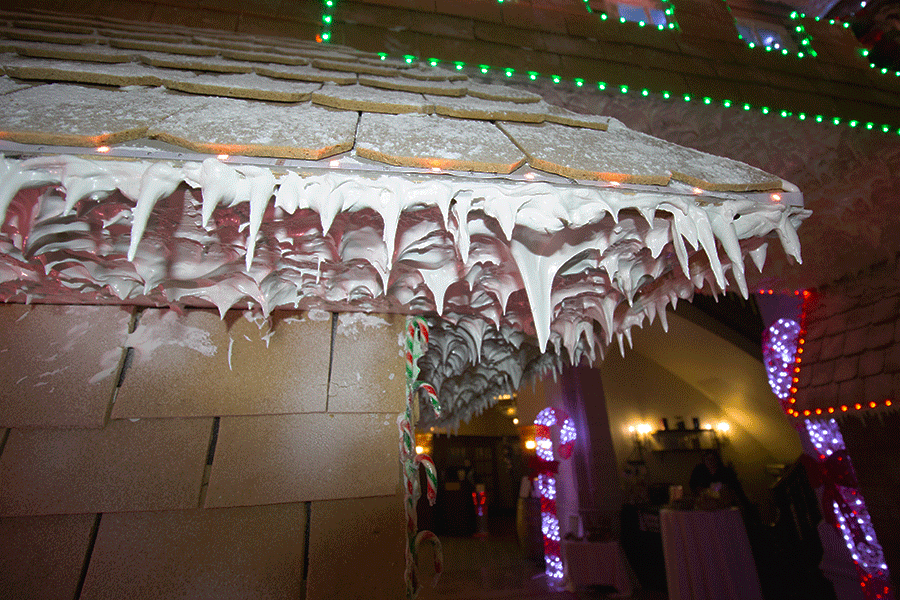Twenty feet tall, 400 kg of flour, 10 kg of cinnamon and limitless holiday spirit

As part of its annual holiday festivities, the culinary staff at Edmonton’s Hotel Fairmont Macdonald make enough gingerbread to feed an army of Santa’s elves. It’s food, but it’s not exactly for eating. All that gingerbread is used in building some of the most elaborate (technically) edible architecture this side of the North Pole.
“Every year we make something different,” says executive chef JiJu Paul (who earned his Certified Chef de Cuisine designation from NAIT in 2015). The latest effort marks one of his culinary team’s biggest yet.
Upon stepping into the 105-year-old hotel’s lobby, visitors are greeted with a 20-foot-tall cookie castle, accented with icing and bejewelled with candy. It’s 18 feet across, with a centre arch high and wide enough for a family to pass through on their way to the hotel’s Harvest Room restaurant.
Planning for the build, which would ultimately take 28 staff members roughly 600 hours, began in August. Once the team agreed upon a design, hotel engineering staff built a sturdy wooden under-structure. Come mid-November, Paul assigned staff to teams for baking and cutting.
“That [cutting] probably takes the longest because everything has to be precise,” says Paul.

The building team then attached paperback-sized shingles using silicone (for safety’s sake) to the upper storey and affixed the ground-floor pieces with royal icing. Working with the latter is what second cook Brooklyn Reed (Culinary Arts ’21) enjoyed most.
“You stick it on and wonder if it’s going to hold,” she says. “And it falls down to make perfect icicles,” which line the underside of the roof overhang and the top of the arch.
The key, she says, is to ensure the icing thickness is just right. Then she’d apply a mound of it to a piece of parchment paper, press it to the structure, then slowly pull it away to produce a sugary stalactite.
Ingredients for a 20-foot gingerbread house (do not try this at home!)
- 200 kg brown sugar
- 180 kg brown flour
- 220 kg all-purpose flour
- 28 kg icing sugar
- 3 kg cloves
- 25 kg white sugar
- 978 whole eggs
- 52 litres of corn syrup
- 10 litres of molasses
- 20 kg of cinnamon
“It’s so rewarding,” Reed adds. She recalls the day that the first group of school children crowded into the lobby for the official opening of the gingerbread house and took in the scene, complete with a towering, brightly decorated Christmas tree.
“Their eyes just lit up.”
For Paul, that gathering is the point of the exercise (though he likes the teambuilding effect it has on staff, too). For more than a century, the Macdonald has stood as a defining feature of Edmonton’s downtown and a contributor to the city’s identity. Paul wants to help foster connections between it and citizens.
“This is an iconic hotel,” he says. “We want more people to feel part of it.”
The gingerbread house will remain in place for visitors until the first week of January. Or most of it will.
The bits and pieces of candy – in particular the rows of canes tacked temptingly to the corners of the arch and well within reach of fingers little, large or elven – will be long gone by then.
Which is how Paul feels it should be.

Make your own (but much smaller) gingerbread house
A great gingerbread house is a fine balance between baking and building. You’ll need a great recipe, but you’ll also need a template – and to check it twice. Halfway through baking, says Baking and Pastry Arts instructor Trevor Stayer (Culinary Arts ’98, Baker ’03), remove the pieces from the oven, roll them lightly under parchment and recut as needed.
Check out Stayer’s other tips for ensuring square corners for your holiday labour, as well as NAIT’s recipe for gingerbread and the royal icing that holds it all together.
Gingerbread recipe and tips
